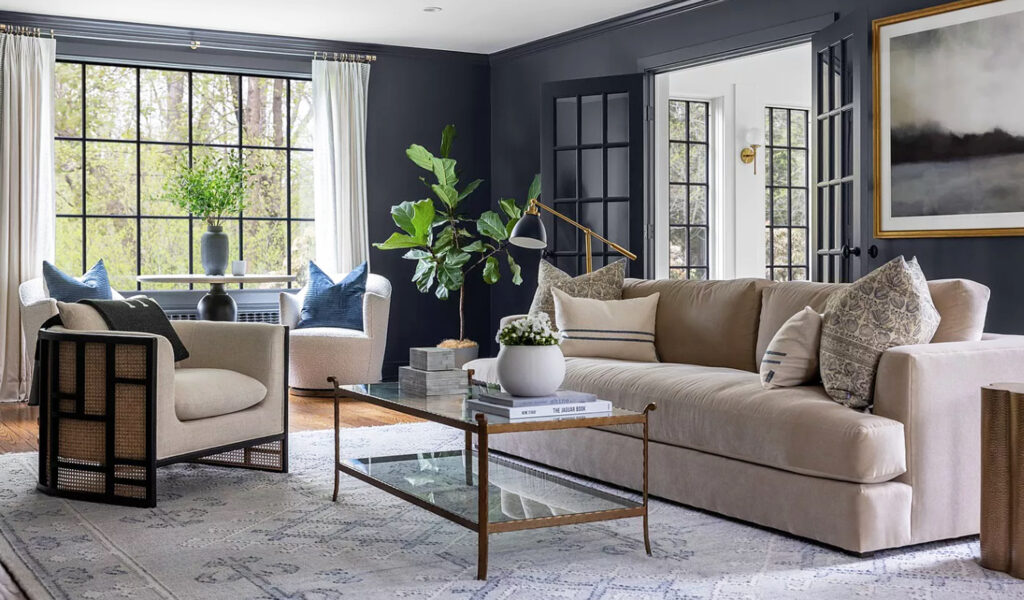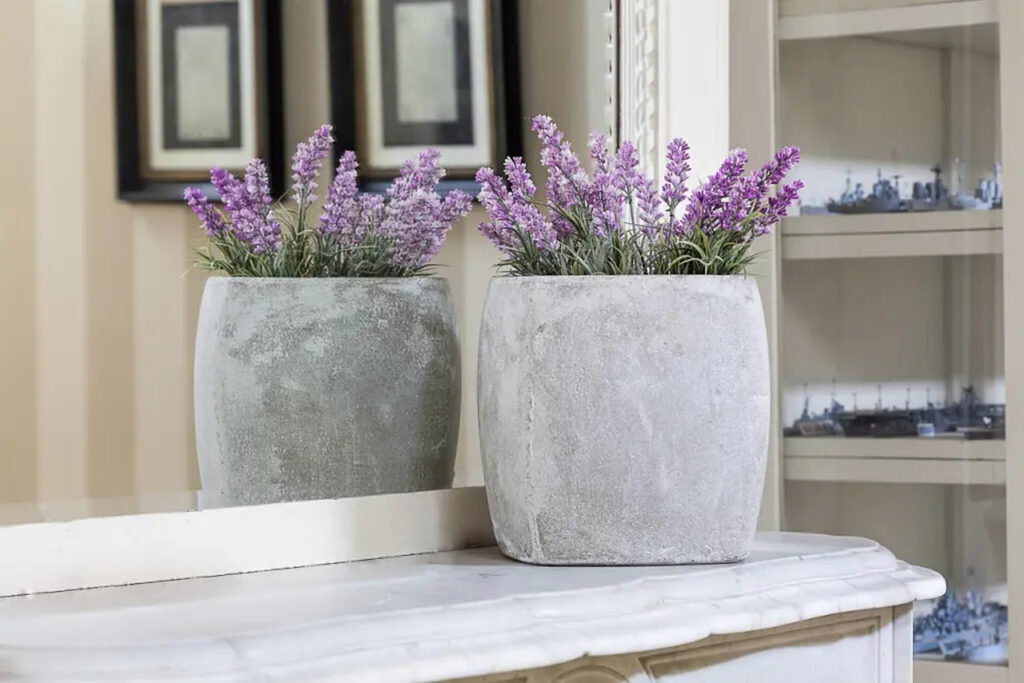Have you noticed how quickly being outdoors can lift our spirits (and our dog’s spirit)? Even if it’s for only 10 minutes our mood improves. This makes perfect sense, because, after all, we are organic beings and we are as natural as nature is. That’s why the sun can lift our spirits and the breeze can free our thoughts while nature’s colors inspire and invigorate us. We feel whole and at home in nature and it begs us to bring that feeling home. Interestingly, more and more people are doing just that – bringing nature inside. But how can we recreate that expansive freeing energy in our rooms? It’s easy and fun when it’s done with intention.
As a holistic designer, I love including natural touches into interiors because they soften and relax our over-stimulated minds, and create a cozy, warm feeling in our homes. It just takes a few well-placed items to achieve that hominess and create a space that allows nature to balance us not overwhelm us. By being mindful, you can incorporate various natural elements — textures, colors, sounds, and scents— that help a home take on the qualities we love when we’re outside. It can make a home feel tranquil, refreshing, spacious, and alive.
In the design world, bringing nature into our décor is known as Biophilic Design, and it is a fast-growing trend. But it needs to be implemented subtly. Remember my mantra, “Less is more” when bringing the outside in. Adding gentle touches into your décor allows the mind to experience it, appreciate its warmth, and its authenticity. Here are a few tips to subtly infuse biophilic accents into your decor.
Go Green with Plants
The easiest way to embrace biophilic design is by adding plants to your space. Just remember, the goal is to infuse nature, not be consumed by it. Too many plants can quickly overpower a room and our senses, which will overwhelm us. Allow the plants to add visual interest and invite you into the room. From statement monstera leaves to cascading pothos, greenery breathes life into interiors; allow it to do that by letting the plant become part of the room’s décor and architecture. When a plant becomes part of the décor, its thoughtful placement will bring balance to the room. This is also true when using multiple plants, they should be placed where points of interest are needed and not randomly scattered about the room. Scattering plants create clutter and distractions, and again, they will overwhelm us. Remember the mantra “Less is more.” The fewer the plants, the more they will be seen and enjoyed. Also, the fewer the plants, the less work is required to keep them healthy and lush, which gives you more time for other interests. Healthy plants are a must for infusing nature into your home. To keep them healthy and vibrant, remove dead leaves and prune them periodically to encourage lush foliage. Fertilize and water them according to their needs, and lastly, always opt for species suited to your home’s lighting and climate. Remove dead plants or struggling plants immediately, the dead or suffering energy adds stress to the home’s energy.
serenaandlily.com
Natural Textures & Materials
Another way to bring the outside in is by using organic materials—wood, stone, rattan, linen— these instantly bring warmth and authenticity to a room. Swap out synthetic fabrics for cotton or wool, add wooden furniture pieces, or introduce stone accents through decorative bowls, pottery, or countertops. Select durable materials for upholstery and heavily used items; then, bring in softer materials in accents, such as cotton or velvet pillows, felted woolens, chunky woven fabrics, wood, wicker, rattan, burlap, etc.
Let Light Lead the Way
Natural light plays a pivotal role in biophilic spaces. Maximize daylight by using sheer window treatments or light-diffused shades, positioning mirrors to reflect sunlight, and opting for warm LED bulbs to mimic daylight. Skylights, solar tubes, and large windows make a dramatic difference in a room’s mood. I highly recommend maximizing natural light, if your architecture allows for it, because it instantly impacts you and the space, but it needs strategic planning for best results. Contact your design professional or contact me to discuss how to maximize the natural light while maintaining coziness and privacy.
Soft, Earthy Color Palettes
Neutral tones inspired by nature are rapidly coming back into vogue. Soft greens, warm browns, sandy beiges, and deep blues help establish a calming environment. Whether through painted walls, textiles, or accents, earthy hues set the stage for a biophilic atmosphere and fill our senses with warmth and tranquility. If your home still has an abundance of white, sprinkle in neutral accents to soften the white and warm the room.
serenaandlily.com
Biophilic Artwork & Imagery
If maintaining plants isn’t your forte, nature-themed artwork can still evoke tranquility. Botanical prints, landscape photographs, and abstract patterns inspired by nature create a visual connection to the outdoors. Again, allow the senses to absorb the imagery. The imagery should whisk your mind to nature’s healing touch. Murals and overly bold wallpaper can overpower a space which can cause agitation, anxiousness, and visual clutter. Wallpaper is another rapidly growing trend. Even so, not all wallpaper designs support our innate needs; take time to find examples of wallpapered rooms similar to your situation to see if they achieve your vision.
Incorporating Natural Sounds & Scents
Biophilic design engages multiple senses. A tabletop water fountain introduces soothing ambient noise, while diffusing pure essential oils like cedarwood, eucalyptus, or lavender brings a fresh, natural scent to your home. Do not use artificial fragrances, plug-ins, scented candles, wax melts, air fresheners, or adulterated essential oils. I cannot emphasize this enough. These are all toxic and pollute the air, causing numerous health issues. Stay tuned for a future article about these dangers. In the meantime, read the article by Force of Nature: “8 Things To Know About Toxic Fragrances”, and use natural alternatives such as fresh flowers, fresh cut eucalyptus or lavender, or diffusing 100% pure organic essential oils. (Note: Take time to research the brand of essential oils before diffusing them, the bottle may claim to be 100% pure and organic, but the FDA only requires 5% of the bottle to be essential oil for it to wear that label. The other 95% can pollute the oil and your air. There are companies that take pride in distilling 100% pure essential oil. Please contact me for more details about essential oils.)
Adding eucalyptus stems to a floral arrangement can enliven a room. Lavender is another plant that can lift the energy of a room while taking your spirit to a higher plane. Lavender can also be grown indoors and makes a lovely addition to a bathroom if there is plenty of natural light. If light is marginal, a mirror reflecting the light from a window can greatly increase the natural light needed for a lavender plant. Just select a porous pot to plant it in, to prevent root rot, and enjoy it for years to come.
hgtv.com
Outdoor-Indoor Transitions
Blurring the line between indoors and outdoors is key for bringing nature into your home. Large glass doors or windows allow the outside world to flood your rooms with their seasonal charm. Even small touches like placing furniture near the windows create a seamless transition between your living space and the natural world, or opening French doors, weather permitting, can make a seamless transition between the indoors and outdoors while freshening a room visually and aromatically. Being able to view the outdoor landscape will literally change your room’s décor as each season comes and goes.
Bringing Nature Home
Biophilic accents aren’t just aesthetic—they improve mood, reduce stress, and enhance overall well-being. Whether introducing greenery, embracing natural textures, or refining your lighting scheme, these subtle touches weave nature into daily life effortlessly.
How do you plan to infuse biophilic elements into your space? Let’s cultivate a sense of calm, one leaf at a time.





Leave A Comment